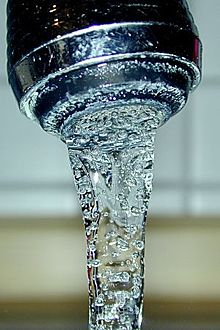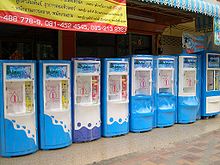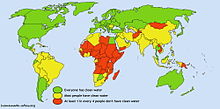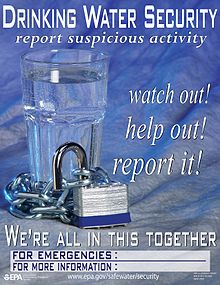- Drinking water
-
Drinking water or potable water is water pure enough to be consumed or used with low risk of immediate or long term harm. In most developed countries, the water supplied to households, commerce and industry is all of drinking water standard, even though only a very small proportion is actually consumed or used in food preparation. Typical uses include washing or landscape irrigation.
Over large parts of the world, humans have inadequate access to potable water and use sources contaminated with disease vectors, pathogens or unacceptable levels of toxins or suspended solids. Such water is not wholesome, and drinking or using such water in food preparation leads to widespread acute and chronic illnesses and is a major cause of death and misery in many countries. Reduction of waterborne diseases is a major public health goal in developing countries.
Water has always been an important and life-sustaining drink to humans and is essential to the survival of all organisms.[1] Excluding fat, water composes approximately 70% of the human body by mass. It is a crucial component of metabolic processes and serves as a solvent for many bodily solutes. The United States Environmental Protection Agency in risk assessment calculations assumes that the average American adult ingests 2.0 litres per day.[2] Drinking water of a variety of qualities is bottled. Bottled water is sold for public consumption throughout the world.
Contents
Requirements
Health authorities have historically suggested at least eight glasses, eight fl oz each (240 mL), of water per day (64 fl oz, or 1.89 litres),[3][2] and the British Dietetic Association recommends 1.8 litres.[1]. This common misconception is not supported by scientific research. Various reviews of all the scientific literature on the topic performed in 2002 and 2008 could not find any solid scientific evidence that recommended drinking eight glasses of water per day.[4][5][6] In the US, the reference daily intake (RDI) for water is 3.7 litres per day (L/day) for human males older than 18, and 2.7 L/day for human females older than 18[7] including water contained in food, beverages, and drinking water. The amount of water varies with the individual, as it depends on the condition of the subject, the amount of physical exercise, and on the environmental temperature and humidity.[8] An individual's thirst provides a better guide for how much water they require rather than a specific, fixed quantity.
In terms of mineral nutrients intake, it is unclear what the drinking water contribution is. However, inorganic minerals generally enter surface water and ground water via storm water runoff or through the Earth's crust. Treatment processes also lead to the presence of some minerals. Examples include calcium, zinc, manganese, phosphate, fluoride and sodium compounds.[9] Water generated from the biochemical metabolism of nutrients provides a significant proportion of the daily water requirements for some arthropods and desert animals, but provides only a small fraction of a human's necessary intake. There are a variety of trace elements present in virtually all potable water, some of which play a role in metabolism. For example sodium, potassium and chloride are common chemicals found in small quantities in most waters, and these elements play a role (not necessarily major) in body metabolism. Other elements such as fluoride, while beneficial in low concentrations, can cause dental problems and other issues when present at high levels. Water is essential for the growth and maintenance of our bodies, as it is involved in a number of biological processes.
Profuse sweating can increase the need for electrolyte (salt) replacement. Water intoxication (which results in hyponatremia), the process of consuming too much water too quickly, can be fatal.[10][11]
Access
Although covering some 70% of the Earth's surface, most water is saline. Freshwater is available in almost all populated areas of the earth, although it may be expensive and the supply may not always be sustainable. Sources where water may be obtained include:
- ground sources such as groundwater, hyporheic zones and aquifers.
- precipitation which includes rain, hail, snow, fog, etc.
- surface water such as rivers, streams, glaciers
- biological sources such as plants.
- the sea through desalination
- Water supply network
Spring water, a natural resource from which much bottled water comes, generally contains minerals.[12] Tap water, delivered by domestic water systems in developed nations, refers to water piped to homes through a tap. All of these forms of water are commonly drunk, often purified through filtration.[13]
The most efficient way to transport and deliver potable water is through pipes. Plumbing can require significant capital investment. Some systems suffer high operating costs. The cost to replace the deteriorating water and sanitation infrastructure of industrialized countries may be as high as $200 billion a year. Leakage of untreated and treated water from pipes reduces access to water. Leakage rates of 50% are not uncommon in urban systems.[14]
Because of the high initial investments, many less wealthy nations cannot afford to develop or sustain appropriate infrastructure, and as a consequence people in these areas may spend a correspondingly higher fraction of their income on water.[15] 2003 statistics from El Salvador, for example, indicate that the poorest 20% of households spend more than 10% of their total income on water. In the United Kingdom authorities define spending of more than 3% of one's income on water as a hardship.[16]
The Millennium Development Goal of halving the proportion of people without access to safe drinking water between 1990 and 2015 will probably be reached. Some countries though still face enormous challenges.[17]
Rural communities are the furthest from meeting the 2015 MDGs drinking water target. Globally only 27% of the rural population has water piped directly to their home and 24% rely on unimproved sources. Of the 884 million people without access to an improved water source, 746 million people (84%) live in rural areas. Sub-Saharan Africa has made the least progress in improved water sources since 1990, improving only 9% to 2006. In contrast, the Eastern Asian region saw a dramatic drop from 45% to 9% reliance on unimproved water in the same time period.[18]
Percentage of population with access to safe drinking water (2000) [19] Country % Country % Country % Country % Country % Albania 97 Algeria 89 Azerbaijan 78 Brazil 87 Chile 93 China 75 Cuba 91 Egypt 97 India 84 Indonesia 78 Iran 92 Iraq 85 Kenya 57 North Korea 100 South Korea 92 Mexico 88 Moldova 92 Morocco 80 Mozambique 57 Pakistan 90 Peru 80 Philippines 86 Singapore 100 South Africa 86 Sudan 67 Syria 80 Turkey 82 Uganda 52 Venezuela 83 Zimbabwe 83 Note: All industrialized countries (as listed by UNICEF at 2000) with data available are at 100%. In the U.S, the typical nonconserving single family home uses 262 L of water per capita per day. In some parts of the country there are water supplies that are dangerously low due to drought, particularly in the West and the South East region of the U.S.[20]
Improving availability
One of the Millennium Development Goals (MDGs) set by the UN includes environmental sustainability. In 2004, only forty-two percent of people in rural areas had access to clean water.[21]
Solar water disinfection is a low-cost method of purifying water that can often be implemented with locally available materials.[22][23][24][25] Unlike methods that rely on firewood, it has low impact on the environment.
One organisation working to improve the availability of safe drinking water in some the world's poorest countries is WaterAid International. Operating in 26 countries [26], WaterAid is working to make lasting improvements to peoples' quality of life by providing long-term sustainable access to clean water in countries such as Nepal, Tanzania, Ghana and India. It also works to educate people about sanitation and hygiene.[27]
The Global Framework for Action (GF4A) is an organization that brings together stakeholders, national governments, donors and NGOs (such as Water aid) to define manageable targets and deadlines. 23 Countries are off-track to meet the MDG goals for improved water availability.[28]
Well contamination
Some efforts at increasing the availability of safe drinking water have been disastrous. When the 1980s was declared the "International Decade of Water" by the United Nations, the assumption was made that groundwater is inherently safer than water from rivers, ponds, and canals. While instances of cholera, typhoid and diarrhea were reduced, other problems emerged. In India for example, 60 million people are estimated to have been poisoned by well water contaminated by excessive fluoride, which is dissolved from the granite rocks. The effects are particularly evident in the bone deformations of children. Similar or larger problems are anticipated in other countries including China, Uzbekistan, and Ethiopia. Although helpful for dental health in low dosage, fluoride in large amounts interferes with bone formation.[29]
In a related problem, it is estimated that half of the Bangladesh's 12 million tube wells contain unacceptable levels of arsenic due to the wells not being dug deep enough (past 100 M). The Bangladeshi government had spent less than $7 million of the 34 million allocated for solving the problem by the World Bank in 1998.[29][30] Natural arsenic poisoning is a global threat, 140 million people affected in 70 countries on all continents.[31] These examples illustrate the need to examine each location on a case by case basis and not assume what works in one area will work in another.
Diarrhea as a major health effect among children
Over 90% of deaths from diarrheal diseases in the developing world today occur in children under 5 years old.[citation needed] Malnutrition, especially protein-energy malnutrition, can decrease the children's resistance to infections, including water-related diarrheal diseases. From 2000-2003, 769,000 children under five years old in sub-Saharan Africa died each year from diarrheal diseases. As a result of only thirty-six percent of the population in the sub-Saharan region having access to proper means of sanitation, more than 2000 children's lives are lost every day. In South Asia, 683,000 children under five years old died each year from diarrheal disease from 2000-2003. During the same time period, in developed countries, 700 children under five years old died from diarrheal disease. Improved water supply reduces diarrhea morbidity by twenty-five percent and improvements in drinking water through proper storage in the home and chlorination reduces diarrhea episodes by thirty-nine percent.[32]
Water quality and contaminants
Parameters for drinking water quality typically fall under two categories: chemical/physical and microbiological. Chemical/physical parameters include heavy metals, trace organic compounds, total suspended solids (TSS), and turbidity. Microbiological parameters include Coliform bacteria, E. coli, and specific pathogenic species of bacteria (such as cholera-causing Vibrio cholerae), viruses, and protozoan parasites.
Chemical parameters tend to pose more of a chronic health risk through buildup of heavy metals although some components like nitrates/nitrites and arsenic can have a more immediate impact. Physical parameters affect the aesthetics and taste of the drinking water and may complicate the removal of microbial pathogens.
Originally, fecal contamination was determined with the presence of coliform bacteria, a convenient marker for a class of harmful fecal pathogens. The presence of fecal coliforms (like E. Coli) serves as an indication of contamination by sewage. Additional contaminants include protozoan oocysts such as Cryptosporidium sp., Giardia lamblia, Legionella, and viruses (enteric).[33] Microbial pathogenic parameters are typically of greatest concern because of their immediate health risk.
Throughout most of the world, the most common contamination of raw water sources is from human sewage and in particular human faecal pathogens and parasites. In 2006, waterborne diseases were estimated to cause 1.8 million deaths each year while about 1.1 billion people lacked proper drinking water.[34] It is clear that people in the developing world need to have access to good quality water in sufficient quantity, water purification technology and availability and distribution systems for water. In many parts of the world the only sources of water are from small streams often directly contaminated by sewage.
Safety Indicators
Access to safe drinking water is indicated by proper sanitary sources. These improved drinking water sources include household connection, public standpipe, borehole condition, protected dug well, protected spring, and rain water collection. Sources that don't encourage improved drinking water to the same extent as previously mentioned include: unprotected well, unprotected spring, rivers or ponds, vender-provided water, bottled water (consequential of limitations in quantity, not quality of water), and tanker truck water. Access to sanitary water comes hand in hand with access to improved sanitation facilities for excreta. These facilities include connection to public sewer, connection to septic system, pour-flush latrine, and ventilated improved pit latrine. Unimproved sanitation facilities are: public or shared latrine, open pit latrine, or bucket latrine.[35]
Water Treatment
Most water requires some type of treatment before use, even water from deep wells or springs. The extent of treatment depends on the source of the water. Appropriate technology options in water treatment include both community-scale and household-scale point-of-use (POU) designs.[36] A few large urban areas such as Christchurch, New Zealand have access to sufficiently pure water of sufficient volume that no treatment of the raw water is required.[37]
Over the past decade, an increasing number of field-based studies have been undertaken to determine the success of POU measures in reducing waterborne disease. The ability of POU options to reduce disease is a function of both their ability to remove microbial pathogens if properly applied and such social factors as ease of use and cultural appropriateness. Technologies may generate more (or less) health benefit than their lab-based microbial removal performance would suggest.
The current priority of the proponents of POU treatment is to reach large numbers of low-income households on a sustainable basis. Few POU measures have reached significant scale thus far, but efforts to promote and commercially distribute these products to the world's poor have only been under way for a few years.
In emergency situations when conventional treatment systems have been compromised, water borne pathogens may be killed or inactivated by boiling[38] but this requires abundant sources of fuel, and can be very onerous on consumers, especially where it is difficult to store boiled water in sterile conditions and is not a reliable way to kill some encysted parasites such as Cryptosporidium or the bacterium Clostridium. Other techniques, such as filtration, chemical disinfection, and exposure to ultraviolet radiation (including solar UV) have been demonstrated in an array of randomized control trials to significantly reduce levels of water-borne disease among users in low-income countries,[39] but these suffer from the same problems as boiling methods.
Drinking water regulation
Guidelines for the assessment and improvement of service activities relating to drinking water have been published in the form of International standards for drinking water such as ISO 24510.[40]
European Union
The EU sets legislation on water quality. Directive 2000/60/EC of the European Parliament and of the Council of 23 October 2000 establishing a framework for Community action in the field of water policy, known as the water framework directive, is the primary piece of legislation governing water.[41] The Drinking water directive relates specifically to water intended for human consumption.
Each member state is responsible for establishing the required policing measures to ensure that the legislation is implemented. For example, in the UK the Water Quality Regulations prescribe maximum values for substances that affect wholesomeness and the Drinking Water Inspectorate polices the water companies.
United States of America
In the United States, the Environmental Protection Agency (EPA) sets standards for tap and public water systems under the Safe Drinking Water Act (SDWA).[42] The Food and Drug Administration (FDA) regulates bottled water as a food product under the Federal Food, Drug, and Cosmetic Act (FFDCA).[43] Bottled water is not necessarily more pure, or more tested, than public tap water.[44] However, there is evidence that the United States federal drinking water regulations do not ensure safe water, as some of the regulations have not been updated with more recent science. Dr. Peter W. Preuss, who became the head of the U.S. EPA's division analyzing environmental risks in 2004, has been "particularly concerned", and has faced controversy in studies which suggest that regulations against certain chemicals should be tightened.[45]
In 2010 the EPA showed that 54 active pharmaceutical ingredients and 10 metabolites had been found in treated drinking water. An earlier study from 2005 by the EPA and the Geographical Survey states that 40% of water was contaminated with nonprescription pharmaceuticals, and it has been reported that of the 8 of the 12 most commonly occurring chemicals in drinking water are estrogenic hormones.[46] Of the pharmaceutical components found in drinking water, the EPA only regulates lindane and perchlorate. In 2009, the EPA did announce another 13 chemicals, hormones, and antibiotics that could potentially be regulated. The decision on whether or not they are sufficietly harmful to be regulated may not be decided upon until 2012 as it takes time for testing.
Drinking water preferences of other animals
The qualitative and quantitative aspects of drinking water requirements of domesticated animals are studied and described within the context of animal husbandry. However, relatively few studies have been focused on the drinking behavior of wild animals. A recent study has shown that feral pigeons do not discriminate drinking water according to its content of metabolic wastes, such as uric acid or urea (mimicking faeces- or urine-pollution by birds or mammals respectively).[47]
See also
- Plumbing
- Spragg Bags
- Water fluoridation
- Water purification
- Water security
References
- ^ a b Greenhalgh, Alison (March 2001). "Healthy living - Water". BBC Health. http://www.bbc.co.uk/health/treatments/healthy_living/nutrition/healthy_water.shtml. Retrieved 2007-02-19.
- ^ a b U.S. Environmental Protection Agency (EPA). Dallas, TX (2000-05)."Chapter 3: Exposure Scenario Selection". http://www.epa.gov/earth1r6/6pd/rcra_c/pd-o/chap3.pdf. Retrieved 2007-02-19. RCRA Delisting Technical Support Document. p. 8.
- ^ "The Benefits of Water". Cleveland Clinic. Archived from the original on 2007-01-16. http://web.archive.org/web/20070116223719/http://www.clevelandclinic.org/health/health-info/docs/2700/2731.asp?index=7250. Retrieved 2007-02-19.
- ^ Research debunks health value of guzzling water. Reuters, April 2008.
- ^ H. Valtin, Drink at least eight glasses of water a day." Really? Is there scientific evidence for "8 × 8"? Am J Physiol Regul Integr Comp Physiol 283: R993-R1004, 2002.
- ^ Negoianu, Dan; Goldfarb, Stanley (2008). "Just add water" (PDF). J. Am. Soc. Nephrol 19 (6): 1041–1043. doi:10.1681/ASN.2008030274. http://www.asn-online.org/press/pdf/2008-Media/Water%20Study.pdf.
- ^ US daily reference intake values
- ^ Maton, Anthea bj; Jean Hopkins, Charles William McLaughlin, Susan Johnson, Maryanna Quon Warner, David LaHart, Jill D. Wright (1993). Human Biology and Health. Englewood Cliffs, New Jersey, USA: Prentice Hall. ISBN 0-13-981176-1.
- ^ World Health Organization (WHO). Geneva, Switzerland. Joyce Morrissey Donohue, Charles O. Abernathy, Peter Lassovszky, George Hallberg. "The contribution of drinking-water to total dietary intakes of selected trace mineral nutrients in the United States." Draft, August 2004.
- ^ Noakes TD, Goodwin N, Rayner BL, et al. (1985). "Water intoxication: a possible complication during endurance exercise". Med Sci Sports Exerc 17 (3): 370–375. PMID 4021781. http://journals.lww.com/acsm-msse/Abstract/1985/06000/Water_intoxication__a_possible_complication_during.12.aspx.
- ^ Noakes TD, Goodwin N, Rayner BL, Branken T, Taylor RK (2005). "Water intoxication: a possible complication during endurance exercise, 1985". Wilderness Environ Med 16 (4): 221–7. PMID 16366205.
- ^ Schardt, David (2000). "Water, Water Everywhere." Center for Science in the Public Interest, Washington, D.C. Accessed 2010-10-26.
- ^ Hall, Ellen L.; Dietrich, Andrea M. (2000). "A Brief History of Drinking Water." Washington: American Water Works Association. Product No. OPF-0051634.
- ^ United Nations. World Water Assessment Programme (2009). "Water in a Changing World: Facts and Figures." World Water Development Report 3. p.5.
- ^ [1] BBC News The water vendors of Nigeria Referenced 2008-10-20
- ^ [2] page 51 Referenced 2008-10-20
- ^ [3] The Millennium Development Goals Report page 44
- ^ [4] The Millennium Development Goals Report 2009. Referenced 2008-10-20
- ^ United Nations Children's Fund (UNICEF). New York, NY. "Safe Drinking Water." Excerpt from "Progress since the World Summit for Children: A Statistical Review." September 2001.
- ^ March 2008, Cashing in on Climate Change, IBISWorld
- ^ Africa and the Millennium Development Goals [www.un.org/millenniumgoals/docs/MDGafrica07.pdf]
- ^ Conroy, RM.; Meegan, ME.; Joyce, T.; McGuigan, K.; Barnes, J. (Oct 1999). "Solar disinfection of water reduces diarrhoeal disease: an update". Arch Dis Child 81 (4): 337–8. doi:10.1136/adc.81.4.337. PMC 1718112. PMID 10490440. http://www.pubmedcentral.nih.gov/articlerender.fcgi?tool=pmcentrez&artid=1718112.
- ^ Conroy, R.M.; Meegan, M.E.; Joyce, T.M.; McGuigan, K.G.; Barnes, J. (2001). "Use of solar disinfection protects children under 6 years from cholera". Arch Dis Child 85 (4): 293–295. doi:10.1136/adc.85.4.293. PMC 1718943. PMID 11567937. http://www.pubmedcentral.nih.gov/articlerender.fcgi?tool=pmcentrez&artid=1718943.
- ^ Rose A, Roy S, Abraham V, Holmgren G, George K, Balraj V, Abraham S, Muliyil J et al. (2006). "Solar disinfection of water for diarrhoeal prevention in Southern India". Arch Dis Child 91 (2): 139–141. doi:10.1136/adc.2005.077867. PMC 2082686. PMID 16403847. http://www.pubmedcentral.nih.gov/articlerender.fcgi?tool=pmcentrez&artid=2082686.
- ^ Hobbins M. (2003). The SODIS Health Impact Study, Ph.D. Thesis, Swiss Tropical Institute Basel
- ^ http://www.wateraid.org/international/what_we_do/where_we_work/default.asp
- ^ http://www.wateraid.org
- ^ World Health Organization. Global Framework for Action on Sanitation and Water Supply (2009-07-21). "Frequently Asked Questions." Working document.
- ^ a b Pearce, Fred (2006). When the Rivers Run Dry: Journeys Into the Heart of the World's Water Crisis. Toronto: Key Porter. ISBN 9781552637418.
- ^ Bagla, Pallava (2003-06-05). "Arsenic-Laced Well Water Poisoning Bangladeshis". National Geographic News (Washington: National Geographic Society). http://news.nationalgeographic.com/news/2003/06/0605_030605_arsenicwater.html.
- ^ Bagchi, Sanjit (2007-11-20). "Arsenic Threat Reaching Global Dimensions". Canadian Medical Association Journal 177 (11): 1344–45. doi:10.1503/cmaj.071456. ISSN 1488-2329. PMC 2072985. PMID 18025421. http://www.cmaj.ca/cgi/reprint/177/11/1344.pdf.
- ^ WHO/UNICEF, Water for life: making it happen
- ^ EPA. Washington, D.C. "Drinking Water Contaminants: Microorganisms." 2010-09-21.
- ^ U.S. Centers for Disease Control and Prevention. Atlanta, GA. "Safe Water System: A Low-Cost Technology for Safe Drinking Water." Fact Sheet, World Water Forum 4 Update. March 2006.
- ^ Meeting the MDG Drinking Water and Sanitation Target: A Mid-Term Assessment of Progress [www.who.int/water_sanitation_health/monitoring/jmp04.pdf]
- ^ Centre for Affordable Water and Sanitation Technology. Calgary, Alberta. "Household Water Treatment Guide," March 2008.
- ^ Christchurch City Council. Christchurch, NZ. "Our water - Water supply." Accessed 2010-10-26.
- ^ World Health Organization, Geneva (2004). "Guidelines for Drinking-water Quality. Volume 1: Recommendations." 3rd ed.
- ^ Clasen, T.; Schmidt, W.; Rabie, T.; Roberts, I.; Cairncross, S. (2007-03-12). "Interventions to improve water quality for preventing diarrhea: a systematic review and meta-analysis". British Medical Journal 334 (7597): 782. doi:10.1136/bmj.39118.489931.BE. PMC 1851994. PMID 17353208. http://www.pubmedcentral.nih.gov/articlerender.fcgi?tool=pmcentrez&artid=1851994.
- ^ ISO 24510 Activities relating to drinking water and wastewater services. Guidelines for the assessment and for the improvement of the service to users
- ^ Maria, Kaika (April 2003). "The Water Framework Directive: A New Directive for a Changing Social, Political and Economic European Framework". European Planning Studies, (Taylor and Francis Group) 11 (3): 299–316. doi:10.1080/09654310303640. http://www.informaworld.com/smpp/content~content=a713666358~db=all. Retrieved 2009-02-10.
- ^ Pub.L. 93-523; 42 U.S.C. § 300f et seq. December 16, 1974.
- ^ June 25, 1938, ch. 675, 52 Stat. 1040; 21 U.S.C. § 301 et seq.
- ^ EPA. "Ground water and drinking water - Customer Service." Accessed 2010-10-26.
- ^ Duhigg, Charles (2009-12-16). "That Tap Water Is Legal but May Be Unhealthy". New York Times: p. A1. http://www.nytimes.com/2009/12/17/us/17water.html?em=&pagewanted=all.
- ^ http://blogs.ei.columbia.edu/2011/10/05/pharmaceuticals-in-the-water-supply-is-this-a-threat/
- ^ Olah G, Rózsa L (2006). "Nitrogen metabolic wastes do not influence drinking water preference in feral pigeons". Acta Zoologica Academiae Scientiarum Hungaricae 52 (4): 401–406. http://www.zoologia.hu/list/olah_rozsa.pdf.
External links
- National Pesticide Information Center - Pesticide in Drinking Water Fact Sheet
- National Pesticide Information Center - Antimicrobials for Food Processing and Drinking Water Systems
- Drinking water at the Open Directory Project
- U.S. Centers for Disease Control and Prevention (CDC) Healthy Water - Drinking Water One-stop resource for drinking water including information on tap water, water wells, fluoridation, water testing, water-related diseases and contaminants, etc., plus links to EPA, WHO, and other resources
- US Environmental Protection Agency - National drinking water program - General info, regulations & technical publications
- WHO - Water Sanitation and Health: drinking water quality
- WHO - Water Sanitation and Health: potabilization systems
- The International Water Association
- Waterwedrink - Links to worldwide drinking water quality websites
- COVSA American veterans raise money for safe water wells in Vietnam
- UNICEF State of the World's Children 2009 Full Report with Statistics
- In Historic Vote, UN Declares Water a Fundamental Human Right - video report by Democracy Now!
Categories:
Wikimedia Foundation. 2010.







